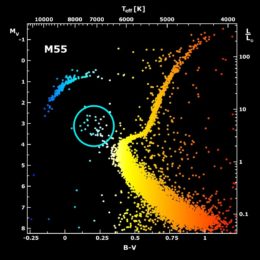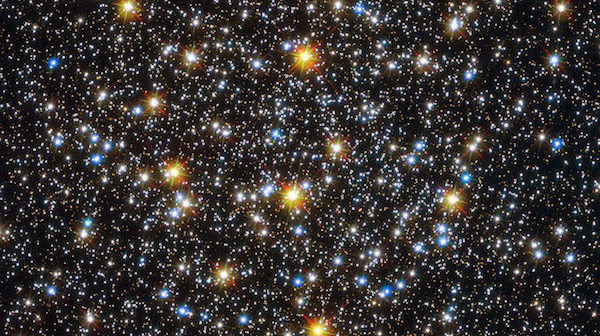As stars age, they gradually lose angular momentum and spin more slowly. This process occurs so predictably for normal, solar-type stars that we can treat them as cosmic clocks using a technique called gyrochronology. But could the same strategy be applied to an unusual type of main-sequence star called blue stragglers?

The blue stragglers in globular cluster M55 are easily identified in a color-magnitude diagram (cyan circle). [Adapted from B.J. Mochejska, J. Kaluzny (CAMK), 1-m Swope Telescope]
Stars That Linger
Based on their mass and age, we would expect blue-straggler stars to have exhausted their core hydrogen and evolved off the main sequence already. Instead, these oddball objects have managed to loiter long past their time by gaining mass — either by siphoning it from a binary companion star or by consuming another star altogether through a collision.
Blue stragglers are easy to pick out in a star cluster, where they are bluer and brighter than the main-sequence turnoff point on a color–magnitude diagram. Post-mass-transfer stars like blue stragglers also exist outside of clusters, where they can be identified by abnormal chemical abundances or the presence of a white-dwarf companion.
To better understand post-mass-transfer stars like blue stragglers, we would like to know how long ago they accreted mass from their companions. We know that these stars experience a jump in spin rate immediately after mass accretion — but what happens after that point? Do they undergo predictable spin-down like normal, solar-type stars, allowing us to use gyrochronology to determine their post-mass-transfer ages?
Going for a Spin
To explore this question, a team led by Emily Leiner (Northwestern University) studied the rotation-rate slowdown of blue-straggler and other post-mass-transfer stars. Leiner and collaborators compiled a sample of post-mass-transfer binaries of varying ages by selecting stars with spectral types F, G, and K with white-dwarf companions in close orbits. Here, age doesn’t refer to time since the star formed, but rather time since the mass transfer took place.
The very young systems were selected by direct detection of the white-dwarf companion in the extreme ultraviolet. In older systems, the white-dwarf companion is too cool to be visible but can be detected by gravitational microlensing.
Leiner and collaborators combined the age estimates from white-dwarf cooling models with rotation periods derived from photometric or spectral measurements. The authors found that the stars spin faster after the mass transfer, then steadily slow down after about 100 million years since the mass transfer have passed.

Ages and rotation periods for this sample of post-mass-transfer systems. The purple and gold lines are single-star models, while the red and cyan lines are collisional-product models. Click to enlarge. [Leiner et al. 2018]
A Model for Spin-down
To understand the physics of post-mass-transfer star spin-down, the authors compared the observed spin-down to models for single solar-type stars and stellar collision products. They found that the models for the stellar collision products showed distinctly different behavior; the collision products maintained their rapid rotation rates far longer than the single stars or post-mass-transfer stars.
Leiner and collaborators attributed this to the possibility that the collision products don’t form normal stellar magnetic fields and can’t lose angular momentum through magnetic braking the way single main-sequence stars do.
On the other hand, the models for spin-down of single solar-type stars matched the blue-straggler observations well. This suggests that blue stragglers and other post-mass-transfer stars have a promising future as gyrochronometers!
Citation
“Observations of Spin-down in Post-mass-transfer Stars and the Possibility for Blue Straggler Gyrochronology,” Emily Leiner, Robert D. Mathieu, Natalie M. Gosnell, and Alison Sills 2018 ApJL 869 L29. doi:10.3847/2041-8213/aaf4ed

6 Comments
Pingback: AAS Nova – New
Pingback: Natalie Gosnell Publishes Paper, Receives NASA Grant | Colorado Space News
Pingback: Natalie Gosnell Publishes Paper, Receives NASA Grant | SPACE FORCE
Pingback: Natalie Gosnell Publishes Paper, Receives NASA Grant - monsterbizx
Pingback: Natalie Gosnell Publishes Paper, Receives NASA Grant - MillionaireBiz
Pingback: Astrosat Picture of the Month #021 – ASI POEC